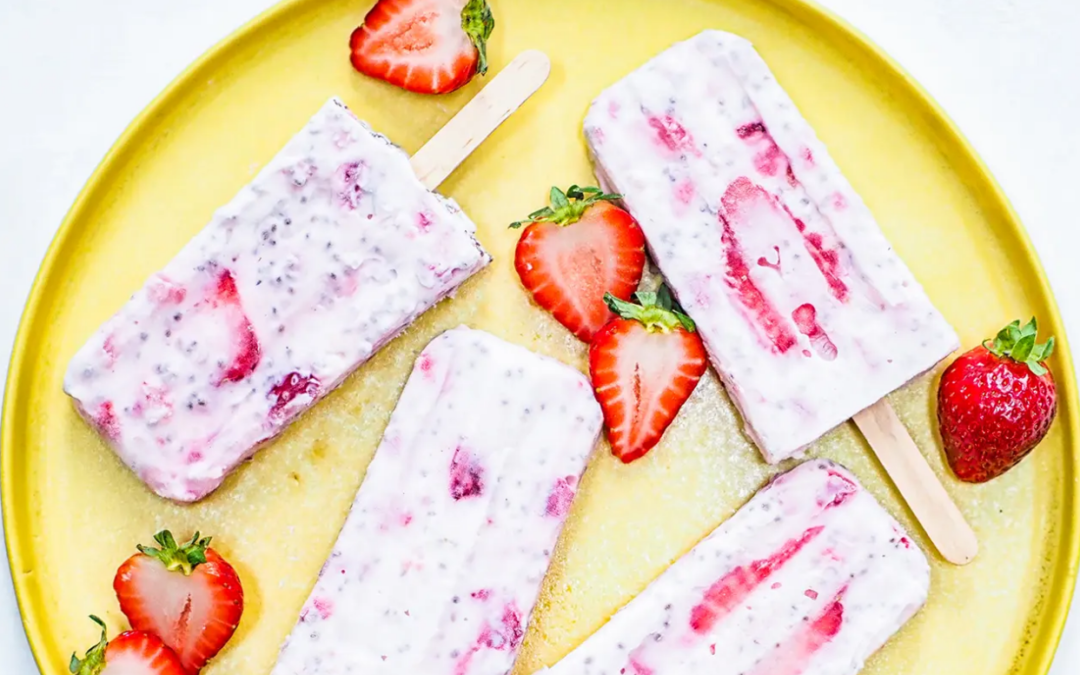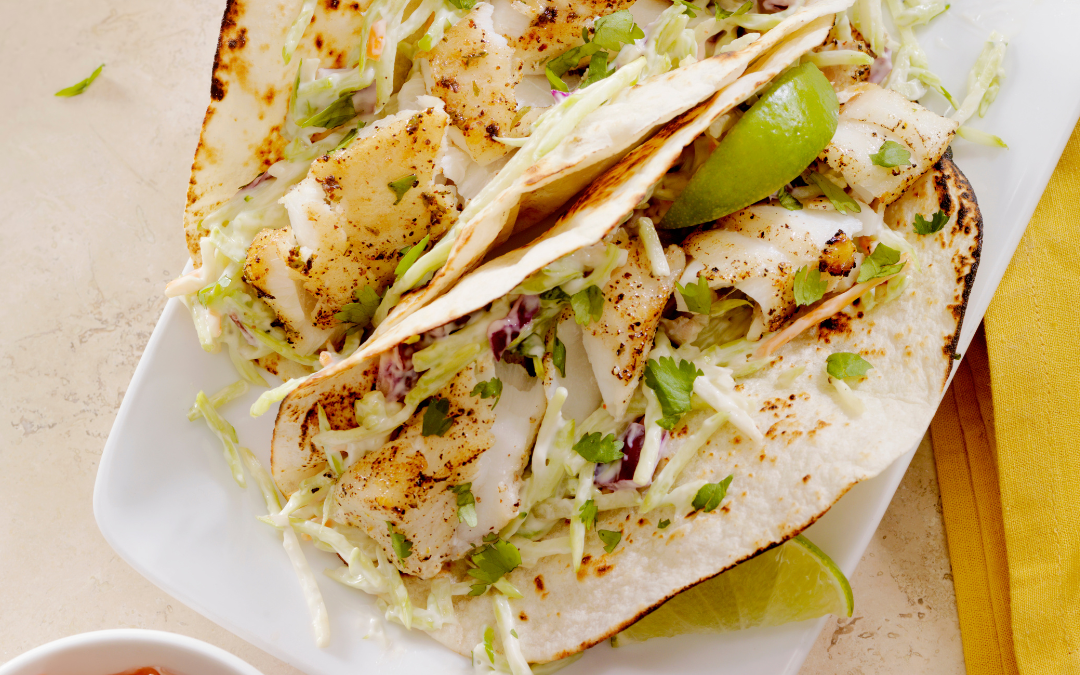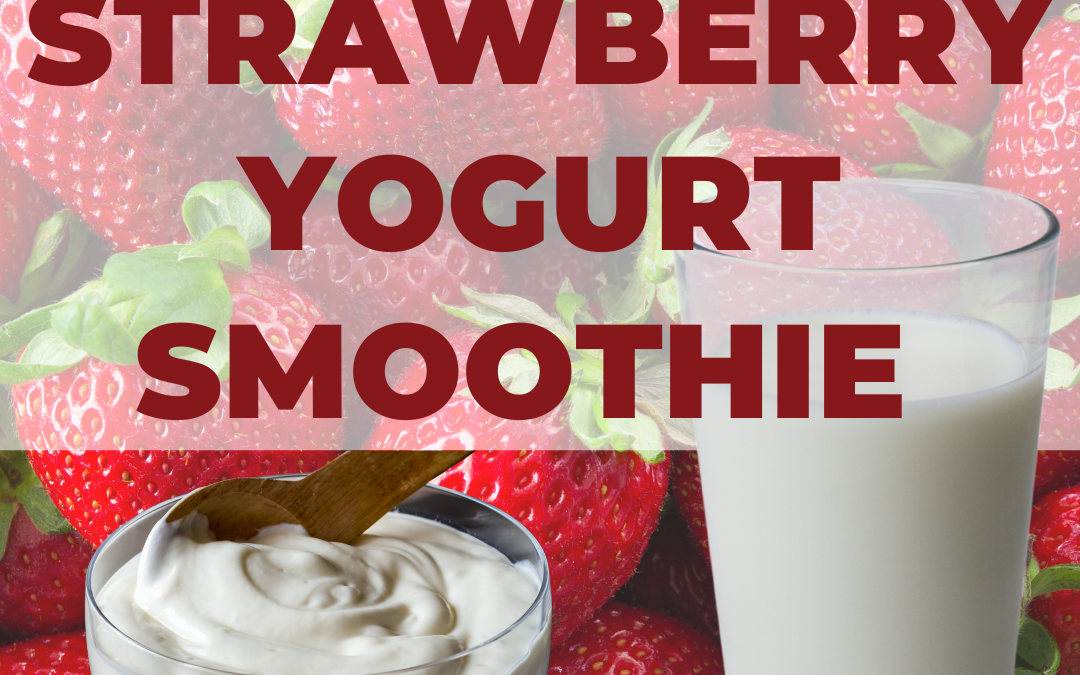
by Guest | Jun 21, 2024 | Eat Well, Featured, Lunch & Snack Recipes, Recipes, Uncategorized
These kid-friendly strawberry chia yogurt pops offer a delicious, healthy way to cool down on a hot summer day! With a winning combo of brain-boosting omega-3 fatty acids, gut-healthy probiotics, and muscle-strengthening protein, this will surely be your new favorite treat to beat the heat.
Ingredients:
1 cup finely chopped strawberries
3 Tbsp honey
2 cups 2% or whole Milk Greek Yogurt
1 Tbsp chia seeds
2 tsp vanilla
6 popsicle sticks
Chia seed garnish (optional)
Instructions:
In a bowl, using a fork, mash ⅓ cup of the strawberries. Add honey and mash to soften. Stir in yogurt, chia seeds and vanilla.
Spoon and divide yogurt mixture into molds, tapping on counter to eliminate air bubbles. Sprinkle with more chia seeds on top (if using) and insert popsicle sticks.
Freeze until solid, 3 to 4 hours. To remove from mold, dip casing into cup of warm water to loosen yogurt pop.
Tip: For a fun decorative look, slice one strawberry. Fill molds halfway and slide a slice directly on wall; top with remaining yogurt mixture.
Submitted by: Lewis Martin, MS, RD, LD, Nutrition Director with Oregon Dairy Counsel

by Guest | Apr 18, 2024 | Being Well, Featured, Uncategorized, Work Well
What is your first memory of being stressed or upset? What was it about? Is it something that would upset you now, all these years later? Maybe, or maybe not. For me, it’s the time my brother knocked over my Lincoln Log house because he wanted one of the pieces I was using (though he would probably tell you a different story).
We all face challenges—even kids. Dare I say, especially kids, as they are still developing the understanding and skills to navigate their world and interactions with others. We as humans are not born with executive function, or the complex ability to think about future consequences, regulate our emotions and impulses, or organize tasks. These are all things that we learn from the environment around us. Most people would probably recognize early interactions and relationships as things that help form a child’s executive function. And they would be correct! The “serve and return” back-and-forth exchange of communication with caregivers is a necessary component in a child’s ability to feel secure in the world and to know how to operate within it. Their executive function allows them to process new anxieties, building resilience. When a child is resilient, the inevitable challenges of life aren’t quite as hard to manage.
So, you’re raising a child. You’re doing all the right things: the bedtime stories, the tummy time, the peek-a-boo. Your child is on the superhighway to mastering executive function! What else could possibly be done? Well, have you checked for lead in your home?
Like, the lead pipe from the board game Clue? The lead that infiltrated the water supply in Flint, Michigan in 2014? Yeah, that lead. You probably already know that lead is bad, but do you know why? Lead is a common and exceptionally potent neurotoxin that accumulates in bones and soft tissue. It damages the brain and central nervous system. In high enough doses, it can cause coma, convulsions, or death. Even in non-fatal cases of lead poisoning, children can be left with permanent brain damage: reduced IQ, reduced attention span, and increased antisocial behavior. In other words, lead can interfere with a child’s development of executive function.
There is no “safe” level of lead exposure, and young children are particularly vulnerable. As a child plays and crawls on the floor, any lead dust or particles on the ground get on their hands. And, as is a child’s nature, those hands go in their mouth. That easily, the dust of the lead paint on the walls is now in the child’s system. This is compounded by the fact that children’s bodies are far less efficient than adult bodies at filtering out lead.
The good news is that lead poisoning is preventable. You can easily find out if an item has lead in it with a home lead testing kit ordered online. Be aware of common sources of lead in the home. Lead-glazed ceramics, water pipes, imported spices and cosmetics, and children’s toys are all common places lead has been found. About 24% of homes and buildings built before 1978 have lead paint. (Note: DO NOT try to sand or scrape off lead paint! This will release more lead dust into the air and can be extremely harmful. If you have lead paint and want to make your home safer, paint over the existing paint and be mindful to clean up any chipping or flaking.) Some jobs and hobbies can also come with lead exposure. Demolition work, manufacturing, renovation, welding, casting or soldering (fishing weights, bullets, stained glass) can all leave lead dust on clothing that is later tracked into the home. To avoid this, leave shoes and work clothes outdoors, wash them, and take a shower before going about your home life. Creating a physically safe environment for your child, one that is absent of lead and other dangers, gives them the capacity to focus on developing as resilient young humans.
Whew! Lead averted. Now that that’s out of the way, we can go back to focusing on the bedtime stories and peek-a-boo…almost.
Lead isn’t the only household toxin. Other common sources of accidental poisonings in children are household cleaning products, personal care/cosmetic products, and analgesics (pain relievers). About 35,000 children go to the emergency room every year after getting into medications and vitamins left within their reach. Those gummy vitamins sure do look like candy, right? Imagine how tempting such a treat is to small hands. Protect your children from accidental poisoning; keep medications, vitamins, and cleaning products up, away, and out of reach. When possible, keep them locked. Never refer to medicine as “candy” to get your child to take it, and teach them to never eat something that wasn’t given to them by a trusted adult, even if it looks like candy.
Parents and caregivers: I know the list of everything you do for your kids is always growing, and it just grew a little more. Your hard work is recognized. All those veggies they don’t want to eat, the emotional guidance, late nights, and disputes over Lincoln Logs can be exhausting unlike anything else. But remember this: the environment you are creating, the support you provide, and your watchful eye are sculpting your child’s executive function, their whole health. And you’re doing an amazing job.
Written by: Sarah Ermer, MPH, CHES; Tillamook Family Counseling Center
Sources:
Centers for Disease Control and Prevention. (2021, October 29). Childhood Lead Poisoning
Prevention: Populations at Higher Risk. Retrieved from
www.cdc.gov/nceh/lead/prevention/populations.htm?CDC_AA_refVal=https%3A%2F%2F
www.cdc.gov%2Fnceh%2Flead%2Ftips.htm
Centers for Disease Control and Prevention. (2023, February 24). Early Brain Development.
Retrieved from www.cdc.gov/ncbddd/childdevelopment/early-brain-development.html
Centers for Disease Control and Prevention. (2022, May 17). Lead in Foods, Cosmetics,and Medicines. Retrieved from www.cdc.gov/nceh/lead/prevention/sources/foods-
cosmetics-medicines.htm
Centers for Disease Control and Prevention. (2022, February 2). Lead in Jobs, Hobbies, or
Other Activities. Retrieved from www.cdc.gov/nceh/lead/prevention/sources/jobs-
hobbies-activities.htm
World Health Organization. (2023, August 11). Lead poisoning. World Health
Organization.https://www.who.int/news-room/fact-sheets/detail/lead-poisoning-and-
health

by Guest | Dec 7, 2023 | Being Well, Featured, Why I'm In
Why are you “IN”?
The Tillamook County Wellness “Why I’m In” interview series highlights our community partners and what has inspired and motivated them to work toward the common goal of improving community health.
“WHY I’M IN …” An interview with Janeane Krongos, Prevention Specialist, Tillamook Family Counseling Center (TFCC). Janeane is the co-chair of the health and promotion committee.
What drew you/your organization to partner with Tillamook County Wellness?
Janeane: Being part of the Tillamook County Wellness (TCW) Health Promotion committee was a natural choice for me, because TCW and I have a shared goal of improving community health through increasing protective factors. Protective factors are characteristics or attributes that can help to lower the risk of negative health outcomes such as diabetes, substance misuse, underage substance use prevention, problem gambling, and suicide prevention. Examples of protective factors include access to basic needs (food and housing), social connections, connection to the community, access to resources, access to healthcare, coping skills, and problem-solving skills.
What, if any, changes have you seen come about as a result of this work?
Janeane: One change that I have seen since I have been part of this group is an increased focus on prevention topics (substance misuse, problem gambling prevention, and suicide prevention) and mental health in TCW content on the website and social media. I think this is a beneficial change and I hope to see more content on these topics.
What have you learned from being involved in this work?
Janeane: I am relatively new to the Tillamook County, I moved to the community in March 2020. Being part of the committee has allowed me to learn about Tillamook County directly from committee members who know the area well. In the monthly meetings I had opportunities to meet with people who are active in the community. Additionally, I have learned about local places that I can go to exercise (local parks, hiking trails, beaches, & facilities), local organizations, community resources, and community events.
What are your hopes for this work as it relates to you/your organization?
Janeane: The organization that I work for (Tillamook Family Counseling Center) has played an active role in TCW since its inception. I hope that they will continue to play an active part in TCW. As for myself, I hope that I will continue to play an active role in TCW. I am the current co-chair of the Health Promotion committee. I enjoy having this role. I respect the members of the group, enjoy the meetings, and enjoy having opportunities to share prevention messaging and share helpful resources in TCW content. Since I have been part of this committee, I have had opportunities to write blogs on a variety of topics including problem gambling prevention, safe medication practices, suicide prevention, and mental health.
What are your hopes for this work as it relates to changing community health in Tillamook County.
Janeane: One hope that I have for the future, is for more community members to get involved in TCW. Currently TCW has around 80 partners who volunteer their time and skills and around 50 community partner organizations who allow staff to attend the meetings. A person can get in TCW in whatever way that works best for them. Examples of ways a person can get involved include: joining a TCW committee(Health Promotion, Access to Care, Access to Physical Activity, and Workplace Wellness), participating in TCW campaigns(This Way to Well-Being), attending TCW programs(walking groups, workshops, or events), sharing your ideas by filling out surveys, following TCW on social media, engaging with TCW social media post (like, share, and comment), subscribing to the TCW newsletter, or making a donation to TCW on the website.
What are your hopes for this work as it relates to changing community health in Tillamook County?
I hope that TCW continues to have strong partner support and continues to generate relevant and trusted health inspiration content.
Other wellness questions? Email us at info@tillamookcountywellness.org. For more local health and wellness information, visit www.tillamookcountywellness.org or follow Tillamook County Wellness on Facebook and Instagram.





